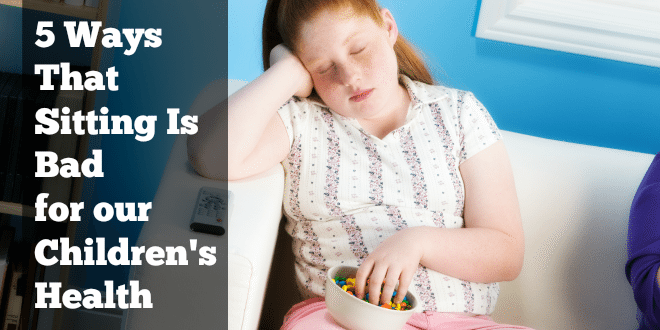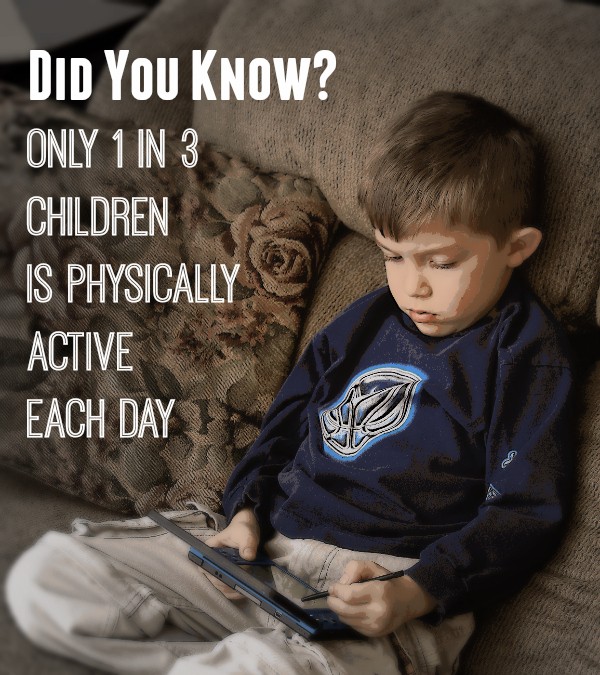5 Ways That Sitting Is Bad for our Children's Health

 Google " kids won’t sit still
" and you’ll see a plethora of concerned parents and teachers wondering why little Johnny and Jodie have trouble staying patiently glued to their chairs all day.
Google " kids won’t sit still
" and you’ll see a plethora of concerned parents and teachers wondering why little Johnny and Jodie have trouble staying patiently glued to their chairs all day.
Now try searching " childhood obesity." Lots of stuff there too. In the U.S., more than a third of children are overweight, and 1 in 6 are full-blown obese[1]. Only 1 in three children is physically active each day[ 2 ]. The statistics are similar throughout the "developed world".
The connection between these two searches is not coincidence. It’s not just correlated, it’s causal.
Sitting all day is unnatural, and forcing our children to do so is contributing to the obesity epidemic.
Here are five ways that relegating our society’s youngest members to chairs is increasing childhood obesity, and hurting children’s health. And then what to do about it.
5 Ways That Sitting Is Bad for our Children's Health (and what you can do about it)
1. Sitting is Bad for Kids Too
 We've all seen the negative health effects of sitting, including an increased risk of obesity. Well guess what? Those effects apply just as much to children, and are just as negative.
We've all seen the negative health effects of sitting, including an increased risk of obesity. Well guess what? Those effects apply just as much to children, and are just as negative.- Sitting increases all-cause mortality (death)
- Sitting is as big a risk factor for heart disease as smoking
- Sitting causes muscular atrophy
- Sitting decreases bone density
- Sitting reduces circulation
- Sitting reduces metabolic flexibility (obesity researcher speak for “makes you fat”)
I’m sure that none of that is stuff you want to be doing to your children.
2. Sitting Damages Children’s Bodies Especially
Human bodies are designed to walk, squat, lie down, jump, climb, etc. Human bodies are not designed to sit.
So what happens when we take children - with bodies still untouched by chronic sitting - and force them into chairs? Their bodies adapt to the new environmental stimulus, and that’s not a positive thing if they’re interested in any other type of activity.
From a comprehensive study of human postures and movements:

For the photo-impaired, the most relevant passage:
“Hamstring length decreased throughout childhood and adolescence, but there was a marked drop around the age of 6 years, which they attributed to increased chair sitting when the children started school.”
This is heartbreaking. For no good reason, we’re forcing kids to sit down in class, and literally deforming their previously healthy bodies. And that damage may last for life!
3. Sitting Slows Children’s Metabolisms
Sitting poses a metabolic problem for all of us, children included. You've likely already read that sitting decreases your metabolic expenditure (that’s calories burned) compared to standing. This study showed that standing desk users burned more calories than sitters in a classroom specifically.

But the metabolic problems caused by sitting go way beyond simple calories. Extended sitting decreases the amount of circulating lipoprotein lipase, a fat-burning enzyme. As we've discussed at the QuittingSitting blog, we think this makes perfect sense:
Your body’s cells, especially those in your brain, have a preference for glucose. If you’re sitting, your blood pools in your legs, meaning your heart and brain get a lower volume of blood. Although the blood volume available to your brain decreases, your brain’s demand for glucose does not. So your blood sugar rises (again, found in the research ), leaving less room for free fatty acids in your blood, so fat burning gets down-regulated.
When I say slow (or more accurately, weak and inflexible) metabolism, you likely think the chief concern is obesity. But poor metabolic conditioning, or "metabolic syndrome" has been linked to many more severe conditions, including diabetes, cancer, and heart disease.
Here’s a flowchart detailing what we think is happening here:

As you can see - extended, chronic sitting is a serious health risk. So ditching those awful school desks and getting our children standing does our society’s health a great service.
4. Sitting is Part of a Convenience Environment
In the first world, most adults now have the entire internet in the palm of their hand. And a pile of apps for easily calling rides, ordering food, and recording TV shows on our DVRs. It’s hard to drive more than a few blocks without seeing a drive-through. Our malls have elevators and escalators. Our airports, moving walkways, to ensure the fewest possible number of steps walked. There’s no doubt we live in a convenience-first culture.
[caption id="attachment_18420" align="alignright" width="300"]
 Hmmmm.... too convenient?[/caption]
Hmmmm.... too convenient?[/caption]Children are often largely exempt from smartphones and spreadsheets. And if they’re lucky enough to have health-conscious parents, they’re mostly exempt from fast food too.
But our children are indoctrinated into this convenience culture with chairs. There’s no doubt that sitting is easier than standing - that’s sort of the point. But “easier" is not often the path to health.
If we give our children the chance to stand - maybe they won’t grow up to be as closely wed to convenience as our adults are.
5. It’s Inertia - Sitting Begets Sitting
Newton’s first law, “a body at rest stays at rest,” applies outside of physics class. You know exactly what I mean. If you've sat around lazily all day, it’s much harder to get your butt out for a jog. Your body and mind get accustomed to the ease of inactivity, and doing anything with effort seems unpleasant.
You have a lifetime of experience to know that if you do get up and get something done, you’ll feel good about it. Children don’t have that experience to fall back on, or the prescience to know how rewarding action can be in that case.
But don’t take my word for it, look at the data. After sitting all day in class, children aren't jumping up to be active. In fact, in the last few decades, active play has all but disappeared, as the average child now spends 7.5 hours in front of a screen on their down time [ 3 ]. 7.5 hours!
https://www.youtube.com/watch?v=3Uiuh_ZZKwg
Getting children out of chairs breaks that inertia, and pays a sort of compounding interest for the rest of the day.
Instead of plodding from seat to seat, children who spend more time standing in the classroom will carry an active inertia - “a body in motion stays in motion” - and will be more active on breaks and after school.
And I know when I was a kid, once I was actively playing outside, I never wanted it to end! That’s healthy inertia.
So let’s put our children on the healthy path. And one small step is allowing them to stand up in class.
https://www.youtube.com/watch?v=hBSVZdTQmDs
What You Can Do to Improve Children’s Health
The absolute best thing we can do is to get standing desks in every classroom. Stand Up Kids is an organization with designs on getting more students standing - you can join their mailing list to hear about how to help.
[caption id="attachment_18421" align="aligncenter" width="636"]
 Outstanding pupils! Primary school becomes first in Europe to introduce desks allowing children to stand up while working in bid to improve concentration and health.[/caption]
Outstanding pupils! Primary school becomes first in Europe to introduce desks allowing children to stand up while working in bid to improve concentration and health.[/caption]For your own children, try to work with their schools to allow standing. You can work it out for specific desks or classrooms on the cheap with DIY desks, or even just lab tables and stools.
Regardless of the progress you make in their environment outside the home, you have complete control over their environment inside the home. So take full advantage!
If they have a desk at home, convert it to a standing desk. Ditch your couch, and get them standing when they watch TV too. Heck, you could even consider getting a standing-height table for your family dinners.
Just getting your kids standing at home can have a huge impact on all the points we discussed above - and result in healthier lives for your children.
Because less sitting means more activity means healthier children. It’s that simple.
[divider style="solid" top="20" bottom="20"]
 Bio:
Bio:
Kit Perkins is the CEO of Ergodriven (creators of Topo | The Not-Flat Standing Desk Mat, which makes standing desks even healthier) and blogs regularly at Quitting Sitting.
For readers of this blog, Kit and Ergodriven have graciously set you up with a $20 credit for pre-ordering Topo. Click here to check it out (credit automatically applied to each mat in your order).
[divider style="dashed" top="20" bottom="20"]





































































































